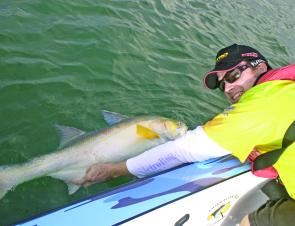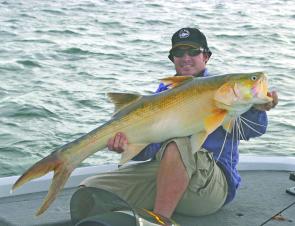Long standing rainfall records are finally being shattered around the south east and while it has upset the fishing, we are more than happy to take a back seat for a couple of weeks.
Relief in the form of continual east coast low pressure systems has brought torrential rains not only to the coast but further inland where we need it the most. Some areas received as much as 350mm overnight during January. There are short term disadvantages as fish become harder to locate, seeking refuge from all that fresh water. Estuarine fish tend to move to deeper water around the river mouths where the salinity levels remain stable and food supply is high. Current weather systems look set to continue as good rainfall is expected over the next few months and well into winter so spend some time searching out where the fish are. The best part is that future fish stocks are looking bright for the next few seasons ahead thanks to the big wet.
The murky fresh water that is being flushed out of rivers has made recent fishing a little harder than normal. Dirty water has been extending well out into the bay and further offshore with the bigger tides. For fishermen in the know, this can be an awesome time to target snapper, bream and other pelagics around the islands for the couple of days following the rouge weather. Better fish move in remarkably close to the coastline to forage around the shallows on the abundant schools of baitfish and prawns that get flushed out of the rivers. Locations like Woody Point, Scarborough Reef and the mouth of the Brisbane River will all see a short term spike in prize fish captures. The trick is to look for the deeper water. By using a good sounder and turning up the sensitivity anglers can see how deep the fresh water is (much like a thermocline in fresh water dams). This is a good indicator of how deep you will need to fish and how far towards the mouth the fresh water is actually pushing.
The occasional threadfin salmon is still lurking around, though the numbers of fish have really dropped off and there are plenty of anglers out fishing for them. These fish are timid to any boat traffic so fishing with even another boat in the vicinity will spook threadies and lessen your chances of catching ome. Don’t be afraid to move to different locations and resume fishing. As always photos make the best trophies so take a few snaps and return them to breed.
Try using the ever faithful Jackal TN70 hopped slowly along the bottom with short pauses as the lure drops back to the bottom. Creature type soft plastics around 3” are also working well and catching their fair share of threadies. The biggest advantage to using plastics is other species are also more likely to respond. My best threadfin, a 1.4m fish estimated at 32lb, was caught on a Gene Larew Baby Hoodaddy 3” in Pumpkinseed rigged on a TT’s 1/2oz jighead.
Good rod and reel combos to target these fish consist of rods about 7ft long matched to either a spin reel around the 2500 to 3000 size or a baitcaster. I prefer to use a baitcaster outfit loaded with 8lb Crystal Fireline and my Australian Rod Manufacturers 7ft 2-4kg Shikari rod for these fish, as there is a more direct feel for playing the fish on the other end when they put in a blistering run. My theory is that these fish are cyclic and are in abundance every four years (may be a spawning thing). So the numbers next season may not fish as well as this season has (just a theory). But that won’t stop me from trying.
The bay islands have been fishing well on the early morning sessions over the last few weeks. Good schools of baitfish are holding up around 20 feet of water with plenty of predatory fish smashing through them. School mackerel are occasionally marauding the shallow reefs and making short work of soft plastics. Unless you are prepared to use wire and greatly reduce your chances of catching anything, high losses of jigheads are likely. Try upgrading your leader to one with more tensile strength. Snapper are very sporadic at present and prefer to come on the bite after a spell of bad weather. February has shown in the past to be a good month for the odd, old man knobbie to be caught at night around shallow reef areas when the water is dirty. Use plenty of fresh, oily berley to increase your chances of luring one of these fish to your bait.
Bream and flatties are always on the agenda this month and can be found on the flats during the spring high tides. Use shallow running or surface lures to good effect.
Sooner or later the winds are going to drop long enough to allow for a few trips to the wider grounds. Any trips outside have been limited with the conditions at present so keep the fingers crossed for some better stuff in the near future. Some fishing that I have heard of out wide have consisted of hussar, Maori cod, parrot, pearlies an occasional snapper and yellow and black kingfish.
Good luck this month.
Releasing these beauties ensures a future supply of these fantastic sportfish. They say threadfin over 1.15m are all female so it makes sense – look what the flathead slot limit has done to their viability and stocks.
Reads: 1434

My PB threadfin salmon at 1.4m. It was estimated at 32lb and was worth all the effort.




